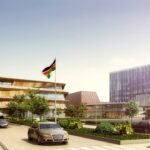Infrastructure development plays a central role in driving the economic growth of any country. A well-developed network of roads, railways, air, and sea transport systems ensures the smooth movement of goods and services, which is essential for boosting economic performance. In Zimbabwe, while progress has been made in building key infrastructure, much work remains to be done to accelerate the construction of critical projects. One of the flagship initiatives is the Mbudzi Roundabout project, a significant undertaking by the government to enhance the country’s road network. Although several roads are being constructed, the real concern lies in whether the current infrastructure is sufficient and whether it can be properly maintained to ensure long-term functionality and improvements to arterial routes.
A well-functioning transport network is indispensable for the rapid movement of goods and people, which is a fundamental requirement for any modern economy. Improved transport infrastructure can lower business transportation costs, reducing overall production expenses and enabling companies to operate more efficiently. In competitive markets, lower costs typically lead to increased output, allowing businesses to expand and gain market share. This, in turn, leads to increased employment and economic growth, particularly in areas where transport costs have decreased.
Across Zimbabwe’s cities and towns, there is an urgent need to address the complex economic, demographic, fiscal, and environmental challenges that impact development. Both the public and private sectors must rethink how they approach infrastructure development to meet these demands. Despite the diversity of these challenges, they all require the same solution: modern, efficient, and reliable infrastructure.
At the core of economic growth are materials like concrete, steel, and fibre-optic cables, which form the foundation of essential infrastructure. Robust infrastructure not only facilitates trade and powers businesses but also connects workers to jobs, creates opportunities for underserved communities, and protects the nation from the growing threat of natural disasters. Private investments in telecommunications, broadband networks, freight railroads, energy projects, and pipelines, alongside public spending on transportation, water systems, and public spaces, are all critical to sustaining a healthy economy.
According to the Minister of Transport and Infrastructural Development, Felix Mhona, progress on Zimbabwe’s infrastructure projects has been steady. During the official opening of the 3 km Glen Norah-Masvingo road, which runs from Amalinda Drive into Glen Norah C, Minister Mhona highlighted the advancements made on the Mbudzi Interchange. The interchange, which consists of 15 bridges (13 on the interchange itself and two on Amalinda Drive and Harare Drive), is nearing completion, with 11 of the bridges already finished. Once completed, the interchange is expected to significantly reduce traffic congestion in and out of Harare’s Central Business District, improving the flow of goods and services.
Reducing road congestion has numerous benefits, particularly for businesses, as it enhances efficiency and reduces stress for motorists. However, Minister Mhona acknowledged the challenges faced by residents living near the interchange, who have been significantly inconvenienced during the construction process. Despite these difficulties, he assured the public that all property owners affected by the project would receive compensation by the end of the month. He emphasized that infrastructure development is crucial for Zimbabwe to achieve its Vision 2030 goal of becoming an empowered upper-middle-income society.
Minister Mhona also praised President Emmerson Mnangagwa for his leadership in championing infrastructure development. “What we have witnessed in the past six years is remarkable. As a nation, we are fortunate to have a visionary leader who is driving development,” Mhona stated. He also reiterated the government’s commitment to adequately compensating homeowners and landowners affected by the Mbudzi Interchange project. With court cases and compensation issues resolved, the focus is now on completing the project by working around the clock, which is also expected to create employment opportunities.
The development of sound road infrastructure is one of the critical pillars for achieving the goals outlined in the National Development Strategy 1 (NDS1), the government’s economic blueprint running from 2021 to 2025. By continuing to invest in and prioritize infrastructure projects, Zimbabwe is laying the groundwork for sustainable economic growth and long-term development.










